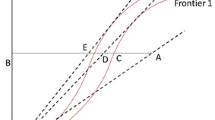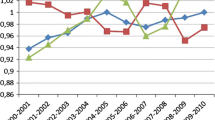Abstract
This paper analyses hospital performance using Data Envelopment Analysis (DEA) and the Malmquist productivity index. We follow two approaches to quantify movements in productivity: (1) the traditional approach that only considers output and input variables; and (2) a more comprehensive approach that incorporates movements in quality and restricts some achievements, if quality is reduced. On the premise that the indicator for quality (nosocomial infections) is equivalent to a bad output, we explore the characteristics of, and compare the results of, the different technological ways to incorporate quality (good or bad attributes, strong or weak disposability technological assumptions). After discussing the virtues and limitations of the existing possibilities, the paper presents a better formulation that allows the preservation of TQM postulates. The decomposition in the Malmquist productivity index shows an improvement in productivity and a positive technical change, especially when quality is introduced.
Similar content being viewed by others
References
Althin, R. (2001). “Measurement of Productivity Changes: Two Malmquist Index Approaches.” Journal of Productivity Analysis, 16, 107–128.
Berg, S.A., F.R. Førsund, and E.S. Jansen. (1992). “Malmquist Indices of Productivity Growth during the Deregulation of Norwegian Banking, 1980–1989.” Scandinavian Journal of Economics (Supplement), 211–228.
Burguess, J.F., Jr. and P.W. Wilson. (1995). “Decomposing Hospital Productivity Changes, 1985–1988: A Nonparametric Malmquist Approach.” The Journal of Productivity Analysis, 6, 343–363.
Calzado, Y., T. García, J. Laffarga, and M. Larran. (1998). “Relación Entre Eficiencia y Efectividad en Los Hospitales del Servicio Andaluz de Salud. Efficiency and Effectiveness in Andalusian Public Hospitals.” Revista de Contabilidad, 1(2), 49–83 (English summary).
Caves, D.W. et al. (1982). “The Economic Theory of Index Numbers and the Measurement of Input, Output, and Productivity.” Econometrica, 50(6), 1393–1414.
Charnes, R.D. et al. (1978). “Measuring the Efficiency of Decision-Making Units.” European Journal of Operational Research, 2, 429–444.
Chilingerian, J.A. and H.D. Sherman. (1990). “Managing Physician Efficiency and Effectiveness in Providing Hospital Services.” Health Services Management Research, 3(1), 3–15.
Crosby, P.B. (1979). Quality is free. McGraw Hill.
Chung, Y.H., R. Färe, and S. Grosskopf. (1997). “Productivity and Undesirable Outputs: A Directional Distance Function Approach.” Journal of Environmental Management, 51, 229–240.
Deming, W.E. (1982). Quality, Productivity and Competitive Position. MIT Center for Advanced Engineering Study.
Donabedian, A. (1980). The Definition of Quality and Approaches to its Assessment. The Regents of the University of Michigan, Ann Arbor, MI
EPINE. (1995). Prevalencia de las Infecciones Nosocomiales en los Hospitales Españoles. Epine 1990–1994. (Nosomial infections in Spanish hospitales, 1990–1994). Barcelona: Sociedad Española de Higiene y Medicina Preventiva Hospitalaria.
Fare, R., S. Grosskopf, and F. Hernandez-Sancho. (2000). “Environmental Performance: An Index Number Approach.” Working Paper, Department of Economics, Oregon State University.
Färe, R., S. Grosskopf, B. Lindgreen, and P. Roos. (1994). “Productivity Developments in Swedish Hospitals: A Malmquist output index approach.” In A. Charnes, W. Cooper, A.Y. Lewin, and L.M. Seiford (eds.), Data Envelopment Analysis. Theory, Methodology and Applications, Kluwer Academic Publishers.
Färe, R., S. Grosskopf, and C.A.K. Lovell. (1994). Production Frontiers. Cambridge University Press.
Färe, R., S. Grosskopf, C.A.K. Lovell, and C. Pasurka. (1989). “Multilateral Productivity Comparisons When Some Outputs are Undesirable: A Nonparametric Approach.” The Review of Economics and Statistics, 61(1), 90–98.
Färe, R., S. Grosskopf, and P. Roos. (1995). “Productivity and Quality Changes in Swedish Pharmacies.” International Journal of Production Economics, 39(1/2), 137–147.
Farrel, M.J. (1957). “The Measurement of Productive Efficiency.” Journal of The Royal Statistical Society Series A, 120, 253–351.
Fixler, D. and K. Zieschang. (1992). “Incorporating Ancillary Measures of Process and Quality Changes into a Superlative Productivity Index.” Journal of Productivity Analysis, 245–267.
Førsund, F. and L. Hjalmarsson. (1979). “Generalised Farrell Measures of Efficiency: An Application to Milk Processing in Swedish dairy plants.” The Economic Journal, 89, 294–315.
Førsund, F.R. (1998). “The Rise and Fall of Slacks: Comments on Quasi-Malmquist Productivity Indices.” Journal of Productivity Analysis, 10, 21–34.
Gowrinsankaran, G. and R.J. Town. (1999). “Estimating the Quality of Care in Hospitals using Instrumental Variables.” Journal of Health Economics, 18, 747–767.
Grabowbski, D.C. (2001). “Medicaid Reimbursement and the Quality of Nursing Home Care.” Journal of Health Economics, 20, 549–569.
Grifell-Tatje, E., C.A.K. Lovell, and J.T. Pastor. (1998). “A Quasi-Malmquist Productivity Index.” Journal of Productivity Analysis, 10, 7–20.
Lovell, C.A.K. and J.L. Zofío. (1997). “Graphyperbolic Efficiency and Productivity Measures.” Paper presented at the Fifth European Workshop on Efficiency and Productivity Analysis, Copenhagen, Denmark.
Malmquist, S. (1953). “Index Numbers and Indifference Surfaces.” Trabajos de Estadística, 4, 209–242.
Murray, R. (1992). “Measuring Public-Sector Output: The Swedish Report in Output Measurement.” In: Z. Griliches (ed.), The Service Sectors, National Bureau of Economic Research, The University of Chicago Press, pp. 517–542.
Newhouse, J.P. (1994). “Frontier Estimation: How Useful a Tool for Health Economics?” Journal of Health Economics, 13, 317–322.
O'Neill, L. (1998). “Multifactor Efficiency in Data Envelopment Analysis with an Application to Urban Hospitals.” Health Care Management Science, 1(1), 19–27.
Ozcan, Y.A. (1995). “Efficiency of Hospital Service Production in Local Markets: The Balance Sheet of U.S. Medical Armament.” Socio Economic Planning Sciences, 29(2), 139–150.
Ozcan, Y.A. and R.D. Luke. (1993). “A National Study of the Efficiency of Hospitals in Urban Markets.” Health Services Research, 28(6), 719–739.
Parasuraman, A., V. Zeithaml, and L. Berry. (1985). “A Conceptual Model of Service Quality and its Implications for Future Research.” Journal of Marketing, 49, 41–50.
Prior, D. and M. Sola. (2001). “Measuring Productivity and Quality Changes using Data Envelopment Analysis. An application to Catalan hospitals.” Financial Accountability and Management, 17(3), 219–245.
Ray, S. and E. Desli. (1997). “Productivity Growth, Technical Progress, and Efficiency Change in Industrialized Countries: Comment.” American Economic Review, 87(5), 1033–1039.
Reinhard, S., C.A.K. Lovell, and G. Thijssen. (1999). “Econometric Estimation of Technical and Environmental Efficiency: An Application to Dutch Dairy Farms.” American Journal of Agricultural Economics, 81(1), 44–60.
Rouse, J. (1997). “Resource and Performance Management in Public Service Organizations.” In K. Isaac-Henry, C. Painter, and C. Barnes (eds.), Management in the Public Sector. Challenge and change, 2nd edn., International Thomson Business Press.
Seiford, L.M. and J. Zhu. (2002). “Modeling Undesirable Factors in Efficiency Evaluation.” European Journal of Operational Research, 142, 16–20.
Simar, L. and P. Wilson. (1998). “Productivity Growth in Industrialized Countries.” Working Paper, Institut de Statistique and CORE, Université Catholique de Louvain, Louvain-la-Neuve.
Sloan, F.A., G.A. Picone, D.H. Taylor Jr. and S.Y. Chou. (2001). “Hospital Ownership and Cost and Quality of Care: Is there a Dime's worth of Difference?” Journal of Health Economics, 20, 1–21.
Tulkens, H. and P. Vanden Eeckaut. (1995). “Non-parametric Efficiency, Progress and Measures for Panel Data: Methodological Aspects.” European Journal of Operational Research, 80(3), 474–499.
Tyteca, D. (1997). “Linear Programming Models for the Measurement of Environmental Performance of Firms: Concepts and Empirical Results.” Journal of Productivity Analysis, 8, 175–189.
Worning, A.M. (1994). “Stratégies de Réduction des Infections Nosocomiales. Un modèle Pour le Développement de la qualité.” (Reduction strategies for nosocomial infections. A quality development model). In: la Santé: Qualité et choix. Paris.
Zofío, J.L., and C.A.K. Lovell. (1998). “Yet Another Malmquist Productivity Index Decomposition.” Mimeo, Departamento de Economía, Universidad Autónoma de Madrid.
Author information
Authors and Affiliations
Corresponding author
Additional information
This paper forms part of a more extensive research work, financed by the Spanish Science and Technology Ministry (ref. SEC2003-047707).
Rights and permissions
About this article
Cite this article
Prior, D. Efficiency and total quality management in health care organizations: A dynamic frontier approach. Ann Oper Res 145, 281–299 (2006). https://doi.org/10.1007/s10479-006-0035-6
Published:
Issue Date:
DOI: https://doi.org/10.1007/s10479-006-0035-6




